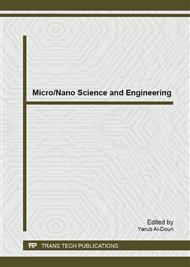p.273
p.278
p.282
p.290
p.295
p.300
p.304
p.308
p.313
Influence of RF Power in the Growth of Aluminium Zinc Oxide (AZO) Thin Films by RF Sputtering
Abstract:
Aluminium doped zinc oxide (AZO) is fast becoming an important thin film material for applications as transparent conducting oxide (TCO) in several thin film solar cells, smart windows and many devices using touch screen displays. This is due to its good electrical and optical characteristics as well as lower cost and good abundance. Although sputtering is the general method for industrial fabrication of this material, but film characteristics depend strongly on fabrication processes. Thus, optimal films are obtained by optimization of the deposition conditions. In this work, we investigated the effects of RF deposition power on AZO thin films. Samples of similar thicknesses were grown under similar conditions in an RF sputtering chamber at different RF powers. The samples were then characterized using FESEM, AFM, UV-Vis, XRD and Hall effect measurement tools. Results indicate that the surface morphology is slightly affected with larger grain sizes obtained at higher RF powers. Also the surface roughness, average transmittance, conductivity and deposition rate all increase with the RF power. The lowest as-deposited resistivity of 15.3x10-3 Ω/cm was obtained, at the highest RF power of 100 W. This film also have the highest values of carrier concentration, mobility and figure of merit of 4.24x1020 cm-3, 0.96 cm2/V and 0.27x10-3 Ω respectively. This work highlights the significance of RF power in the fabrication of good quality AZO thin films.
Info:
Periodical:
Pages:
295-299
Citation:
Online since:
April 2014
Keywords:
Price:
Сopyright:
© 2014 Trans Tech Publications Ltd. All Rights Reserved
Share:
Citation:


